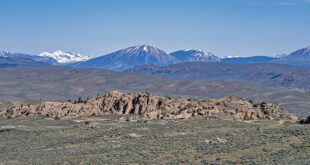The Greek philosopher Heraclitus said, “The only thing that is constant is change.”
There is plenty of change happening right now.
—The leaves are the obvious one. We might be past the peak, so our recent glorious golden days will soon turn into a steady autumn brown. Enjoy the final colors before the wind takes them all.
—Mt. Crested Butte ski shops are changing hands like falling autumn leaves. Flatiron Sports is changing ownership. GJ and Oz have passed the torch to Christy Sports. Also, Steve Bunt sold Crested Butte Sports to a longtime customer from Longmont. Those are big changes up there. Good luck to all those guys.
—As we begin to change our thoughts from single track to powder stashes, it seems a change in the valley clientele now includes a lot more people from the Front Range in both summer and winter.
—Scientists say they are almost certain water flows part of the time on the surface of Mars. That could be a game changer.
—Colorado’s Republican and Democratic senators actually worked together on a good response to a threatened government shutdown. According to the Denver Post, Democrat Michael Bennet and Republican Cory Gardner planned to introduce legislation that would impose strict rules—including the possibility of arrest—on the Senate whenever one or more federal agencies were thrown into shutdown mode. The rationale, said Bennet and Gardner, was to keep lawmakers in town to negotiate. Just these two working together is sort of a change.
—At an economic forum in Gunnison last week sponsored by the Federal Reserve Bank of Kansas City, Denver branch, and hosted by Gunnison Bank and Trust president Ashley Burt, who sits on the branch board—we saw statistics showing that the economy is changing in the state and the region. It is not a quick change but it is changing in the right direction.
—U.S. Energy just went through a major corporate shake-up. It’s too soon to know what that means for a potential molybdenum mine that looms over the upper valley, but change is not only constant, it can be good.
Let’s focus on that last one…
In the many years we have dealt with the Larsens and U.S. Energy, it hasn’t always been the smoothest of relationships. No surprise there. The Larsens would probably agree that they primarily see this valley as a place for a molybdenum mine to make the company some serious cash. I’ve always felt that given the huge start-up costs and giant regulatory hurdles, that idea has been a dream—especially as the price of moly sinks and is now at about five-and-a-half bucks a pound.
Most of us living here now view this place as our home that has shifted away from the mining history of the past and deliberately chosen a new road with recreation and tourism as the prime economic focus.
Mining and tourism naturally brings a certain conflict.
With just a few conversations and absolutely no proof, my gut feeling is that Mark and Keith Larsen have been emotionally invested in the idea of the high-grade molybdenum deposit in part because their father discovered the mother load of some of the highest grade moly in the world. But moly isn’t gold, especially at $5.50 a pound. So, despite gargantuan costs to really get a mine operation even started and the fact that real moly mining companies partnered and then walked away given the realities on the ground, the Larsens just couldn’t let go.

It now appears the Larsens have been pushed from the company founded by their father. New management headed by David Veltri is taking the reins of U.S. Energy. Changes at the top could mean new opportunity.
The Larsens actually changed the company when they expanded into oil and gas and for a while it brought U.S. Energy significant revenue. But oil and gas prices have plummeted this last year and the impact on the company is real. Revenues are shallow and the stock price is horrendous. But the legal obligation to run the water treatment plant on Mt. Emmons costs more every year and stands at about $1.8 million annually.
So the question now is whether there is opportunity with the changes at U.S. Energy to negotiate some sort of final agreement to rid the valley of even the possibility of a mine looming over the west side of Crested Butte. That industrial possibility has been there for decades and while mining has a large history in the community, few think a moly mine three miles from Third and Elk is a progressive idea in these times.
But what sort of solution is possible? The financial and regulatory cost of even getting a mine to pull up the first bucket-load of moly is so huge that it is a long shot unless molybdenum suddenly becomes many times more valuable than the current price. And given the fact that moly is a common byproduct of copper mining, there is absolutely no shortage of molybdenum in the world. A basic understanding of economics (that’s as much as I have) indicates the equation just doesn’t add up to a new mine up the road.
So while there is value in putting the specter of a moly mine to rest, it is not worth selling the farm for. But opportunity is opportunity, so it is certainly worth re-opening talks with a new U.S. Energy management team to see if the new people in charge want to get that liability off their books. We might be able to somehow help them with that.
Assisting the struggling oil and gas company to lose a hard-rock mine liability and make the company more solid financially might just be possible—if the company and community can somehow figure out how to pay for the water treatment plant in perpetuity. I’m not sure what the final solution is, but now could be a good time to start exploring for a new answer.
It seems everyone involved, including the new company CEO, would be open to the kind of change that puts an end to the question and to the fight.
Change is constant and change can be good.
—Mark Reaman
 The Crested Butte News Serving the Gunnison Valley since 1999
The Crested Butte News Serving the Gunnison Valley since 1999






